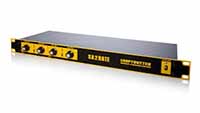Today I would like to focus on the subject of mixing vocals in Hard Rock music. We won’t go deep into any specific trend, as there are too many of them used at mixing and mastering hip hop vocals and each of the approaches has its own peculiarities and preferences. I also won’t try to make a standard “tutorial” describing a range of techniques. On the contrary, let's talk about a general method of working with the vocals and find out what an engineer must take into consideration. As a bonus, you will learn about some technical approaches to solving this task.
Determine the main task
I’m sure that this should be the first step for you as an audio mixing engineer not only in vocals processing and not only in Rock songs. Decide if you would like to “place” the voice inside an arena-like space with a corresponding rich reverberation sound or conversely, into a confined space of a small club. Visualization can really help you choose the right options.
 Another important detail: how “polished” do you want the sound to be?
Another important detail: how “polished” do you want the sound to be?
Many Pop-Punk bands won’t be happy if an audio mixer makes the sound of their songs overly “sleek”. In these genres while mixing vocal over music, you need to deliver the natural sound of voice, so I would recommend keeping the changes of the source material as small as possible.
The Metal genres, on the other hand, require significant changes of the vocal tracks in order to get a more aggressive sound. Generally, the more precisely do you see the final objective and the intended effect, the more conscious the choice of a certain processing will be.
 Balance
Balance
One of the popular approaches in the Heavy Rock genres moves the vocals out of the spotlight. Instead, priority is given primarily to the guitars and snare, which play a key role. This trend is so strong that in the early 90-s you could barely hear the lyrics in some of the songs.
Of course, it’s not a call for an action, as the balance of vocals in the song can change in different parts, based on the trance mixing and mastering services engineer's plan. For example, the verses can be given to the vocals and the chorus can be occupied by the guitars (with additional layers for filling the overall pattern) and the driving beat.
One way or another, you as an engineer need to decide which of the elements plays a key role, so you can build the mix sound on this basis. Forget about the “solo” button on the LV stem – this approach will lead you to no good. Any processing decisions have to be made only in the context of the entire song, where the vocals are not the star of the show, and the priority is given to the guitar sound. The Pop and Hip-Hop music, on the other hand, follows a completely opposite rule – the music mixing studio has to make the voice as “shiny” as possible and make it a center of the song with other instruments revolving around it. If you need more detailed help on the subject please check our mixing mastering services prices.
Tone
This aspect is probably the hardest one, so it’s almost impossible to give recommendations for every occasion. Let’s look at some general approaches, which you should use at the mixing. Our assumption is that the vocals in the track will have to coexist smoothly with a rich guitar sound and punchy drums.
Top End
Remember that our topic is processing Rock Vocals, so whatever is good for Pop or R&B will likely be unsuitable here. You rarely hear a shimmery top end in Hard Rock, so if a rock music mixing and mastering engineer needs to make a singer’s voice brighter, the choice of 10+ kHz range will be a mistake. The appropriate selection would be around 5-8 kHz, which is a more edgy range of high frequencies declared by most mixing engineers.
Generally, paying special attention to the treble processing is only worthwhile if it was insufficient in the record initially, or if it’s intended to “cut through” the bright guitars. The general presence in rock music lies in middle frequencies, and the mixer has to find the right balance of the top end for the voice in the context of the song. Otherwise, the voice completely disappears behind the wall of the guitar sound. Midrange
Midrange
This is where the focal point of this genre vocals lies. There are two most important frequency ranges for the vocals: the upper mids (1-4 kHz) and the 300Hz-1kHz zone (the lower mids). It is the upper midrange that should be the focus in aggressive rock styles (Death Metal, Hardcore), and not the top end. The upper midrange makes the voice fully audible behind the heavy guitars and should be taken to account at online audio services.
Mixing mastering vocal with the emphasis on the lower midrange is more typical for rather gloomy Heavy Rock styles. Here, the engineer might highlight this range in order to keep up the overall vibe, but the level of vocals in the mix will have to be lifted to maintain a correct balance. Interestingly, the vocal track in solo mode might seem too midrangy and etched, but if you turn on all other elements, everything will fall into place!
.jpg) Ambience
Ambience
As a tight rock mix makes it hard to distinguish reverberation details, I am convinced that the more “dry” is the vocal, the better it will fit in the guitar “wall of sound”. Of course, unless the guitar mixing service client is looking for an “arena” type sound I mentioned. Otherwise, a very short room reverb will be more appropriate, or a slap back delay as an alternative. I think that reverberation makes the sound too “right” and “polished”, which isn’t very good for rock songs mixing. However… There are situations when a song or some part of it simply demands an explicit reverberation. In that case, I do exactly the opposite of what was said above – I make a faaaat chamber or plate reverberation to highlight an epochal moment.
Distortion
There is one stereotype among the mixing engineers, for which I have no stomach. It has literally become a standard to apply distortion to the vocal channel when mixing rock music at the earliest opportunity. The usual explanation is “well, it’s a rock song – that’s the way it’s done here!” Yes, distortion of the vocals, of course, makes them more edgy, but when it becomes a mere tribute to the tradition, rather than a well-judged action, this approach turns mixing vocals into a mockery. I don’t have anything against this sort of extra flavor processing, on the contrary, I often use it in my work, but only when it forms a natural addition to the overall mood of the song and highlights music emotionality. I’m sure that’s what your service’s clients expect. If an artificial overload of the vocals makes them sound smoother alongside with the guitar sound, then everything you’ve done was correct and appropriate as a mixing creative solution.
 Cleanup
Cleanup
Another important aspect in working with the vocals is how “clean” you would like them to be as result of before and after mixing and mastering. The lower midrange, which makes the singer's voice sound "full", is also influenced by the side tone of the room, where the recording took place. This range also adds something called “muddiness”, but only if the lower midrange is excessive in the track. The engineer must decide where lies the desired balance between the “fullness” and “muddiness”. First, the overall tone of the LV track should be organized, then its integrity with the guitar and bass must be worked out, and the mud attenuation issue should be left for the end. Maybe when the whole composition is arranged, all parts will work smoothly, so you won’t have to fight for the clean voice lower midrange.
Dynamics
Heavily compressed sound of vocals is very typical for Hard Rock mixing. Every music mix master engineer has its own view on how to work in this case. I prefer start processing dynamics of vocals with a simple level automation, so the compressor is feeded in a uniform way without audible dips or overload. Only after the necessary compression level is reached, I perform the final volume automation of the compressed vocals in order to highlight especially emotional bits with the volume. The result achieved with this approach you can hear in mixing and mastering examples. In addition, notice that Rock music really loves distortion in all its aspects, so if a processing results in somewhat crunchy vocals, it’s no big deal – this will only help the voice make its way through the barrage of the guitars and bashy drums.
